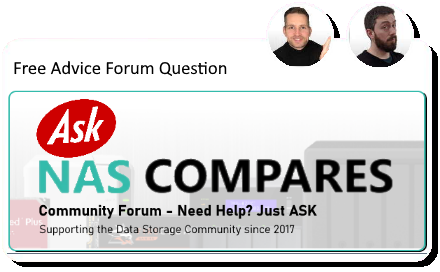
+- ASK NC (https://ask.nascompares.com)
+-- Forum: Q&A (https://ask.nascompares.com/forumdisplay.php?fid=1)
+--- Forum: Before you buy Q&A (https://ask.nascompares.com/forumdisplay.php?fid=2)
+--- Thread: Please help me decide (/showthread.php?tid=12228)
Please help me decide - Enquiries - 08-06-2025
I had an old POS WD 4 x 4TB NAS that decided to die. Now, everything is running in my home server (Proxmox + TrueNAS Scale)
Thinking about buying either a complete solution (6 to 8 bay QNAP, Terramaster or Synology) or DIYing a new one on my own.
Regardless of the solution I pick, I was planning on buying 3 x 8TB drives to start and grow from there as needed, which means adding a drive from time to time.
I heard this is very stressful on the other drives, takes a lot of time and in some instances is not advised. Is this the case? Should I save more and buy all drives at once?
With your experience, which is the best NAS solution for a plan like this? QNAP? Synology? Terramaster? TrueNAS Scale? Unraid?
I think I would prefer to build something in the Jonsbo N3 or N5, but I am concerned about the limitations of DIY NAS software when it comes to add more drives and expand the pools.
RE: Please help me decide - ed - 08-07-2025
Thanks for the message, and sorry to hear about the WD NAS failure — sounds like it gave you a good excuse to finally build something more reliable.
Your plan to start with 3 x 8TB and grow over time is totally reasonable, but you’re right that the way you expand depends a lot on the software and platform you choose.
Some quick thoughts on your expansion question:
• ZFS-based systems like TrueNAS SCALE or TrueNAS CORE do not support expanding an existing vdev by adding drives one at a time. You would need to either:
• Create a new vdev and stripe it (risky in smaller pools),
• Or replace all the drives one-by-one with larger ones, letting the pool auto-expand after the last is replaced — which takes time and strain.
• So yes, adding single drives gradually can be awkward or even discouraged in ZFS.
• Unraid is much more forgiving for your kind of setup. You can add drives one at a time to expand capacity without needing to rebuild the array or reformat anything. Great for gradual growth and mixed-drive sizes. It’s also very user-friendly if you’re going the DIY route.
• Synology (especially with SHR) is very flexible in terms of expanding storage. SHR allows mixing drive sizes and expanding later, and it’s ideal if you want minimal hassle. That said, newer Synology models now enforce branded drives, so unless you find a DS1621+/DS920+/DS1821+ or similar older model, you’ll be tied to their pricing.
• QNAP and TerraMaster offer decent expandability too, especially with RAID 5/6, but traditional RAID still carries the rebuild time/strain issues you mentioned. RAID 6 helps slightly with redundancy during long rebuilds.
⸻
Recommendation based on your plan and budget:
• If you’re leaning DIY and like the Jonsbo N3/N5 idea, Unraid is likely your best option. It’s easy to set up, good for gradual drive additions, and suits mixed workloads (media, VMs, backups).
• If you want something more plug-and-play and less fiddly long term, then a Synology DS1821+ (if you can find one), or a QNAP TS-673A / TS-664 is worth considering. TerraMaster F4-423 is budget-friendly too, but the software is a bit more barebones compared to the others.
If you do go DIY, just make sure you get ECC RAM (especially for ZFS), a decent PSU, and good airflow in the case — especially in the N3, which can run a bit warm depending on your drive config.